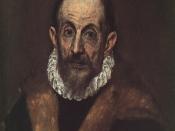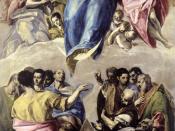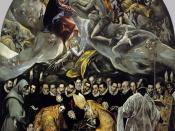DOMENIKOS THEOTOCOPOULOS (EL GRECO) 1541-1614
Domenikos Theotokopoulos was the last and perhaps the greatest mannerist of all time. Born on the island of Crete, Domenikos Theotokopoulos acquired the name El Greco, the Greek, in Italy and Spain. He was first trained in the Venetian School by an unknown Cretanian artist still working under the Byzantine tradition. After working as an icon painter, he left Crete in 1568 to study western-style painting in Venice. There he was influenced by the Venetian artists Titian and Tintoretto, embracing their rich colors and free, sketchy manner of painting. Such early Venetian paintings as his Christ Healing the Blind Man (figure 1) demonstrate his assimilation of Titianesque color and of Tintoretto's figural compositions and use of deep spatial recesses. Further Italian inspiration came during the years El Greco spent in Rome, from 1570 to 1576 where Michelangelo had developed a new style called mannerism in which realistic views of the physical world were looked down upon in favor of a more subjective view, one that existed not in nature but in the intellect.
Space was compressed, colors were bizarre, and figures became elongated and were intertwined in complex poses. Mannerism, from the Italian word for style, was highly self-conscious and artificial, emphasizing the artist's ability. Its intellectual basis appealed to El Greco. The sculptural qualities of the work of Michelangelo also inspired him. A study of Roman architecture reinforced the stability of his compositions, which often include views of Roman Renaissance buildings.
In Rome he met several Spaniards associated with the church in Toledo, who may have persuaded him to come to Spain along with the fact that he failed to win major commissions in Rome. In 1576 he left Italy and, after a brief stopover in Malta, arrived in Toledo in the spring of...



Perfect
this is like all that i was looking for, in a short form, without going over the web and interpreting the different pieces of info. Great, at least that's my opinion.
1 out of 1 people found this comment useful.